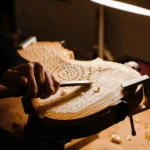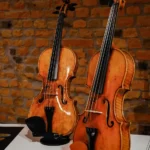The Legendary Guarneri ‘Del Gesu’
Back to BlogThe Legendary Guarneri ‘del Gesù’
If you are a passionate violin lover, then you must have come across the name of the legendary Guarneri “del Gesù”. Did you know that he shares the platform with Antonio Stradivari when it comes to recognized violin makers in History? Besides this, there are many other things that will leave you amazed. Therefore, allow this blog to enlighten you regarding the legendary Guarneri “del Gesù”.
Bartolomeo Giuseppe Guarneri
Bartolomeo Giuseppe Guarneri was more famously known as Guarneri “del Gesù” which means “Of Jesus”. His instruments have claimed the title of projection, power, and brilliance of sound that remains unbeatable to this date. The magnificence enchanted audiences and musicians for centuries. You must be wondering why Stradivari’s work has been found on records and why not del Gesu’s. The fact is that, unlike Antonio Stradivari, Giuseppe Guarneri del Gesu’s work is reserved in a mystery, which adds to the charm of his remarkable creations.
Early Life and Influences (1698 – 1730)
Born in Cremona, Italy, in 1698, Guarneri del Gesù was the youngest son of Giuseppe Guarneri “filius Andreae” (son of Andrea), himself a distinguished violin maker. While the exact details of his early training remain unclear, he likely received his initial tutelage under his father’s watchful eye. The Guarneri workshop was already established within the esteemed Cremonese violin-making tradition, fostering a deep understanding of wood selection, crafting techniques, and the delicate balance of form and sound.
The Cremonese Legacy
Cremona, Italy, had become a renowned center for violin making by the 17th century. The Amati family, led by the legendary Andrea Amati, laid the foundation for the instrument’s design and construction. Stradivari and the Guarneri family, along with others, further refined the Amati model, each developing their own distinctive styles and approaches.
Breaking the Mold
While Guarneri del Gesù undoubtedly learned from his father and the Cremonese tradition, he emerged as a more unconventional and experimental maker. His instruments differed from Stradivari’s in several key aspects:
Body Shape
Guarneri del Gesù’s violins often had a narrower waist and a slightly shorter overall length compared to Stradivari’s. This design contributed to a more focused and responsive sound.
Varnish
While Stradivari’s varnish was typically a rich golden brown, Guarneri del Gesù’s varnish ranged from a deep orange-red to a cooler yellow. The exact recipe for his varnish remains a mystery, but it is believed to contribute to the instrument’s distinctive tonal qualities.
The “del Gesù” Nickname
The origin of the nickname “del Gesù” remains a topic of debate. Some theories suggest it might have originated from a religious symbol incorporated into his early labels. Others speculate it could be due to his workshop’s proximity to a church dedicated to Jesus. However, there’s no definitive explanation.
A Life of Mystery (1730 – 1744)
While details about Guarneri del Gesù’s early life are scarce, information about his later years is even more secretive. Records from the 1730s show him living and working in Cremona, but accounts of his personal life are largely absent, leaving little to no evidence. Some speculate he might have had a fiery temperament.
The Golden Period (1730 – 1744)
Despite the lack of biographical details, the instruments Guarneri del Gesù produced during this period solidified his legacy. He created some of the most sought-after violins in history, including the “Cannon,” the “Soil,” the “Ysaÿe,” and the “Vieuxtemps.”
These instruments are renowned for their exceptional power, projection, and brilliance. Musicians like Niccolò Paganini and Hilary Hahn have praised their responsiveness and ability to produce a wide range of colours and dynamics. Guarneri del Gesù’s violins are not just beautiful instruments; they are powerful tools for musical expression.
A Legacy of Innovation and Enigmatic Genius
Guarneri del Gesù died in Cremona in 1744 at the relatively young age of 46. He left behind a relatively small collection of instruments, with estimates ranging from 150 to 250, compared to Stradivari’s much larger output. However, the scarcity and exceptional quality of his instruments have only served to elevate their value and mystique.
The scarce evidence of Giuseppe Guarneri del Gesu brings in more excitement and intrigues violin lovers than as compared to other violin makers, whose works are accessible and other artists take inspiration from.
Conclusion
Curious to get to know more about Guarneri del Gesù work? Explore the timeless legacy of Guarneri del Gesù and discover its modern interpretations on our website. Immerse yourself in the craftsmanship of contemporary luthiers, who draw inspiration from the master’s iconic works through inspired pieces and faithful replicas. Visit our website to explore the rich tapestry of Guarneri del Gesù’s influence on contemporary string instrument craftsmanship or scroll down to see some works.









